Luminescent
Enlightened
- Joined
- Jun 26, 2007
- Messages
- 399
There have been a few recent threads relating to incandescent vs. LED performance in Fog, Snow, Rain, and for general color rendering.
Color rendering is a function of the overall spectral balance (color temperature) and is also influenced by the overall smoothness of the output spectrum (color rendering index).
A white LED source has a big spike in the spectrum at the upper end, due to blue light leaking through the phospher layer, and the output spectrum balance is influenced by the phosphor mix used and the consistency of the manufacturing process.
Even under ideal conditions, the spiky nature of the white LED's spectrum will put an upper limit the quality of the color rendering.
Unfortunately, most incandescent flashlights do NOT necessarily have a very good CRI either.
Yes, it's true that under LAB or studio lighting conditions, with a very high temperature halogen lamp running from a STABLE voltage source, you can get a very good Color Rendering Index, but in a flashlight, due to the variable conditions of battery voltage, the lamp is rarely running near the optimum voltage needed for a good CRI.
Incandescent flashlights shift spectrum as the battery voltage changes, and some LED lights start out with horribly skewed color balance right out of the gate due to manufacturing variability (the famous Luxeon Lottery).
To look at the practical color rendering quality that can be achieved by LED lights and incandescent lights, I thought some actual example images would be helpful.
Here are some examples from several LED lights, and a classic 2 D-Cell Maglight incandescent.
For each sample image, a reference image shot with a daylight balanced xenon flash is shown on the left and the light being tested is shown on the right. For consistency, in each case the white balance of the camera is locked to the "Daylight" setting unless otherwise noted.
Note: Due to the 'Luxeon Lottery' any light can get a good or bad bounce on color rendering, so I am listing the names of these lights only for reference, not to imply that these particular light models have any better color rendering than any other.
Dorcy 3 D-Cell (Luxeon) -
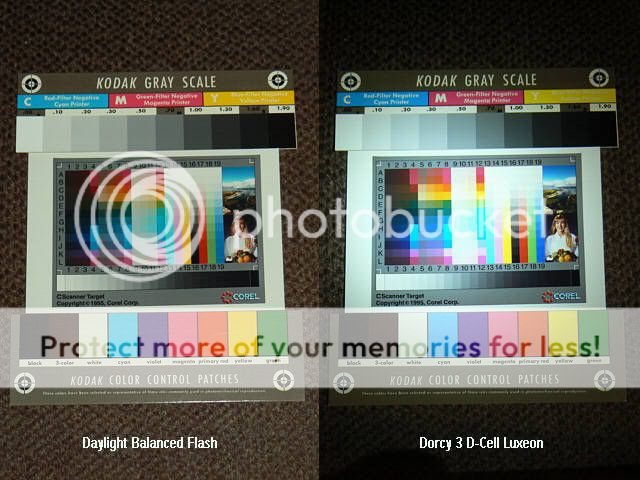
My Dorcy 3 D-Cell Luxeon is a few years old but has a virtually perfect white beam. The light has a very deep reflector, and is so tightly focused that it will out throw any of the Mag incandescent lights and most current generation of 200 lumen CREE lights.
Folks can talk all they want about how great incandescent lights are on color balance, but it's a fact of nature that your eyes need a certain minimum level of illumination to perceive any color at all.
The Dorcy 3 D-Cell light will show clear colors at distances where a incandescent Maglight's beam shows only indistinct dim gray outlines.
Jetbeam C-LE (CREE P4) -
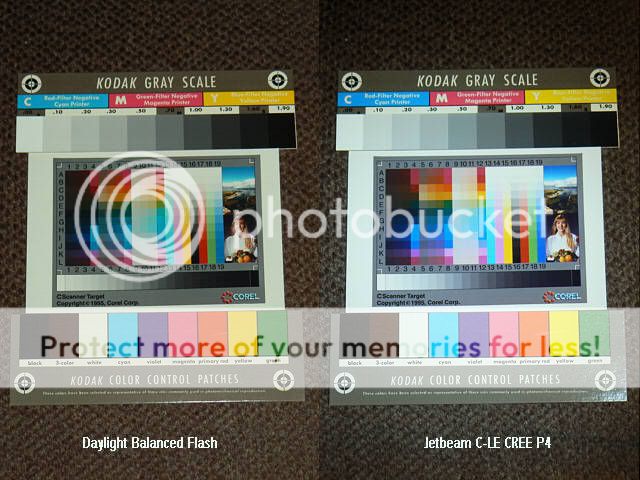
The Jetbeam C-LE was quite inexpensive for a high quality CREE light, but has an orange peel reflector with a very clean white beam.
Fenix L0D-Q4 (CREE Q4) –
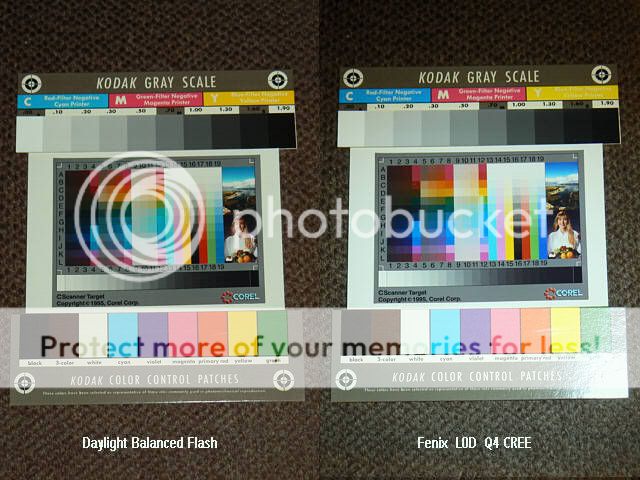
The L0D-Q4 is the smallest light I own, but also has one of the best color balances.
Maglight Incandescent 2 D-Cell (camera daylight balanced) -
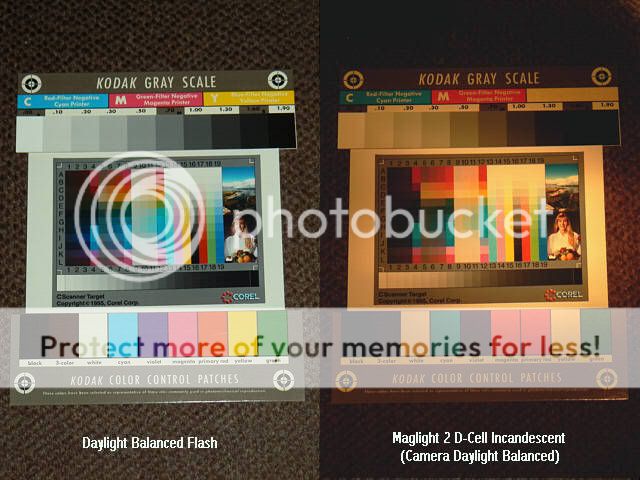
This first Maglight incandescent image shows just how far into the RED the spectrum of a incandescent light appears when viewed using the same 'daylight' color balance on the camera that was used for the LED lights above.
Some claim that incandescent lights work better in fog, because the droplets don't backscatter this redshifted light as much as the purer higher color temperature white light generated by an LED. This may be true, but an LED light with an AMBER FILTER should do just as well.
Maglight Incandescent 2 D-Cell (camera tungsten balanced) -
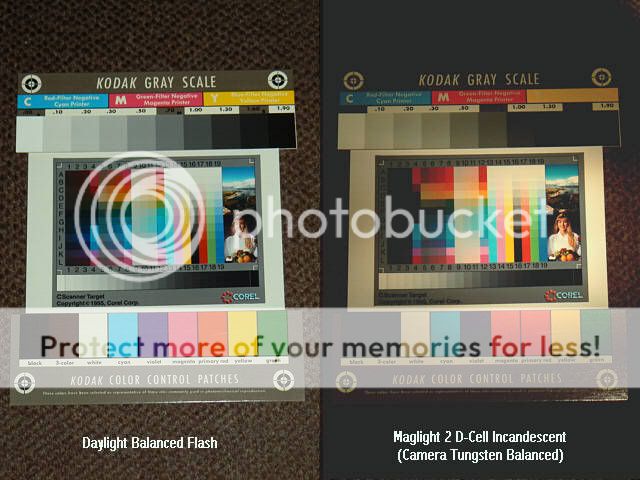
This final image shows that with the proper corrections applied (as would be done by your eye's natural white balance), even the reddish lower color temperature light from an incandescent can give reasonably good color rendering. Though this looks much better with the proper corrections applied, it's still a little bit of a stretch to conclude that the incandescent is better overall.
In general it looks like the incandescent does a bit better in the oranges and reds, where the LED's give more pop to blues and fluorescent colors.
Color rendering is a function of the overall spectral balance (color temperature) and is also influenced by the overall smoothness of the output spectrum (color rendering index).
A white LED source has a big spike in the spectrum at the upper end, due to blue light leaking through the phospher layer, and the output spectrum balance is influenced by the phosphor mix used and the consistency of the manufacturing process.
Even under ideal conditions, the spiky nature of the white LED's spectrum will put an upper limit the quality of the color rendering.
Unfortunately, most incandescent flashlights do NOT necessarily have a very good CRI either.
Yes, it's true that under LAB or studio lighting conditions, with a very high temperature halogen lamp running from a STABLE voltage source, you can get a very good Color Rendering Index, but in a flashlight, due to the variable conditions of battery voltage, the lamp is rarely running near the optimum voltage needed for a good CRI.
Incandescent flashlights shift spectrum as the battery voltage changes, and some LED lights start out with horribly skewed color balance right out of the gate due to manufacturing variability (the famous Luxeon Lottery).
To look at the practical color rendering quality that can be achieved by LED lights and incandescent lights, I thought some actual example images would be helpful.
Here are some examples from several LED lights, and a classic 2 D-Cell Maglight incandescent.
For each sample image, a reference image shot with a daylight balanced xenon flash is shown on the left and the light being tested is shown on the right. For consistency, in each case the white balance of the camera is locked to the "Daylight" setting unless otherwise noted.
Note: Due to the 'Luxeon Lottery' any light can get a good or bad bounce on color rendering, so I am listing the names of these lights only for reference, not to imply that these particular light models have any better color rendering than any other.
Dorcy 3 D-Cell (Luxeon) -

My Dorcy 3 D-Cell Luxeon is a few years old but has a virtually perfect white beam. The light has a very deep reflector, and is so tightly focused that it will out throw any of the Mag incandescent lights and most current generation of 200 lumen CREE lights.
Folks can talk all they want about how great incandescent lights are on color balance, but it's a fact of nature that your eyes need a certain minimum level of illumination to perceive any color at all.
The Dorcy 3 D-Cell light will show clear colors at distances where a incandescent Maglight's beam shows only indistinct dim gray outlines.
Jetbeam C-LE (CREE P4) -

The Jetbeam C-LE was quite inexpensive for a high quality CREE light, but has an orange peel reflector with a very clean white beam.
Fenix L0D-Q4 (CREE Q4) –

The L0D-Q4 is the smallest light I own, but also has one of the best color balances.
Maglight Incandescent 2 D-Cell (camera daylight balanced) -

This first Maglight incandescent image shows just how far into the RED the spectrum of a incandescent light appears when viewed using the same 'daylight' color balance on the camera that was used for the LED lights above.
Some claim that incandescent lights work better in fog, because the droplets don't backscatter this redshifted light as much as the purer higher color temperature white light generated by an LED. This may be true, but an LED light with an AMBER FILTER should do just as well.
Maglight Incandescent 2 D-Cell (camera tungsten balanced) -

This final image shows that with the proper corrections applied (as would be done by your eye's natural white balance), even the reddish lower color temperature light from an incandescent can give reasonably good color rendering. Though this looks much better with the proper corrections applied, it's still a little bit of a stretch to conclude that the incandescent is better overall.
In general it looks like the incandescent does a bit better in the oranges and reds, where the LED's give more pop to blues and fluorescent colors.
Last edited:

